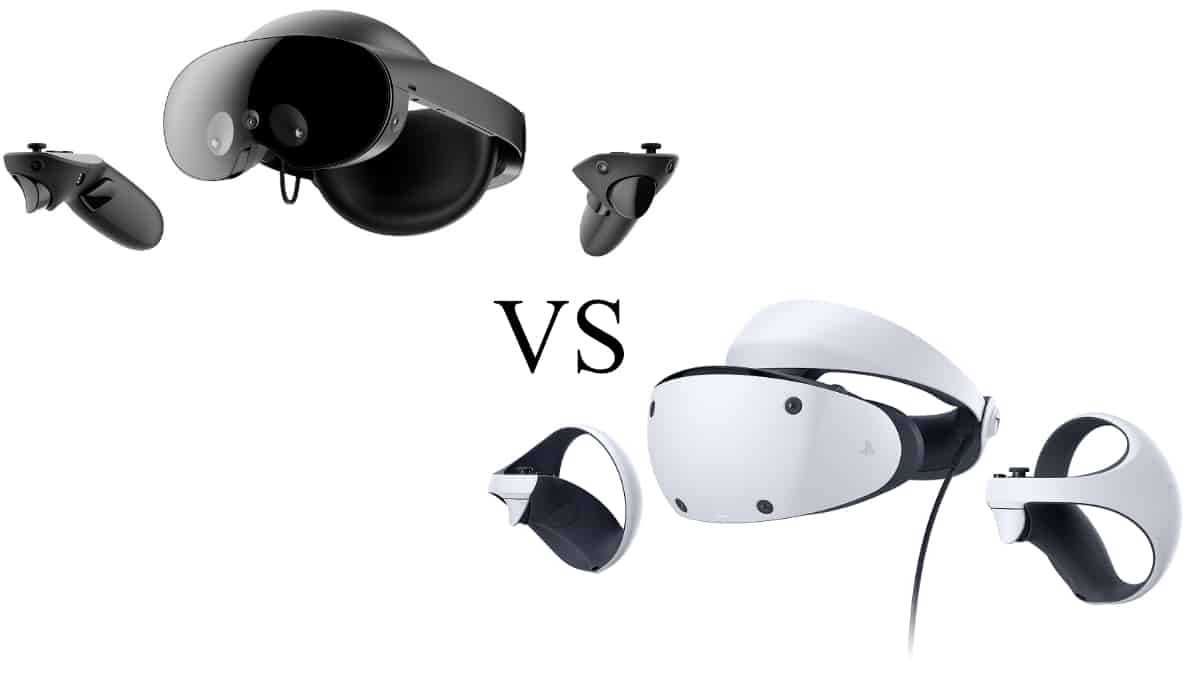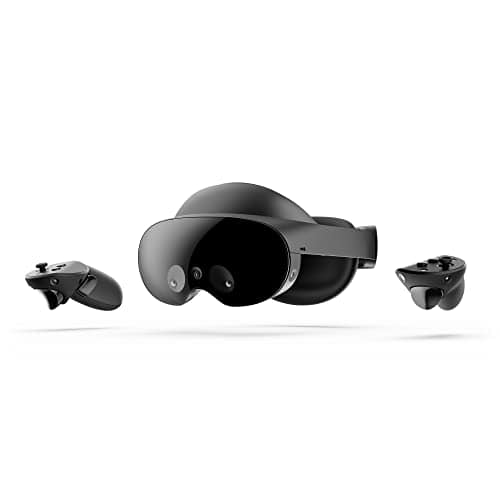Meta Quest Pro vs PSVR 2

Table of Contents
The VR world is witnessing some immense changes. From immersive working-related environments to the most life-like gaming experiences, VR devices are starting to impress even the most unlikely candidates as the space unfolds.
For now, one of the most trifling battles lies between the newly debuted Meta Quest Pro, the successor of the classic Oculus Quest 2, versus the upcoming PlayStation VR 2. In this article, we’ll dive into how both devices stack up against each other according to all available information.
Meta Quest Pro vs PSVR 2: Design
Both devices have been made to look stylish and tech-focused. The black pitch color, plus the rounded edges give the Quest Pro a futuristic and comfortable look. The main issue with the Quest Pro design is its 722g of weight, which can make it feel quite heavy on one’s head.
Meta has engineered this aspect with some ingenuity. They placed the battery at the back of the head strap so that the whole weight of the device balances out across one’s head. That way the user won't feel their face being pulled down as what was experienced in the Quest 2.
Another great aspect of the Quest Pro is how comfortable it is to use. Not only the balanced weight but the fact that this is mainly a wireless device gives you a more immersive feel when wearing the headset. Overall, the Meta Quest Pro is a compact device that will feel and look perfect on anyone.
The PSVR 2, on the other hand, comes in characteristic black and white PlayStation colors. It also has rounded edges and a solid white finish on the front. Unlike the Quest Pro, the front portion of the PSVR 2 makes it appear more like a gaming device than the former. Besides, the PSVR 2 weighs almost 100g less than the Quest Pro. At 630g, the PSVR will feel a lot smoother on one’s head, and that will help make users forget about the real world and immerse them in the game.
Meta Quest Pro vs PSVR 2: Display
The display is one of the key differences between both devices. The Meta Quest Pro uses so-called pancake optics technology to ensure the maximum amount of pixels per inch in such a compact device. The Meta Quest Pro can only achieve an 1800×1920 screen resolution per eye, which is impressive but falls short when we consider the competition.
The PSVR 2 offers full 4k resolutions at 2000×2040 per eye with an incredible 110° FoV. These characteristics give the PSVR 2 display a robust advantage over the Meta Quest Pro.
Furthermore, the PSVR 2 has two OLED screens which allow for great visual fidelity. The high contrast and perfect pitch colors, plus the 120Hz refresh rate, make the PSVR 2 display feel powerful and all the more real. According to early testers of the PSVR 2, the image quality was among the greatest upgrades for the device. The 4K resolution, refresh rate, and immersive field of view offer incredible returns.
While the PSVR 2 intends to completely separate the “real world” from the VR, the Meta Quest Pro offers a mixed-reality environment. For that reason, they have a more narrow FoV set at 96° with a maximum refresh rate of 90Hz. According to Meta, these specific display configurations create a view that blends with reality and enables you to multitask and complete work more easily, reducing motion sickness and eye fatigue.
Meta Quest Pro vs PSVR 2: Eye-tracking
Sony partnered with eye-tracking provider Tobii to enhance the tracking capabilities of the device. The PSVR 2 has four cameras for the headset and controller tracking, and an IR camera for eye tracking per eye. The device can detect every eye movement, “allowing for heightened emotional response and enhanced expression when meeting fellow players online,” according to the PlayStation blog post.
Meta, besides offering the necessary eye-tracking mechanism, gambled with a facial tracker for its Quest Pro. The VR headset has 6 DoF Inside-out via five integrated cameras, a feature that allows the device to create an avatar of the user by scanning one’s face in a matter of seconds. This is a great feature for online simulators or gambling games. Alongside this, the eye-tracking features feel natural and speedy. The system can swiftly read where your eyes are looking and gives immediate feedback, according to early testers.
Meta Quest Pro vs PSVR 2: Specs
Sony has been releasing specs and features of their as-of-yet unreleased PSVR 2 system. Here's a table of the available information so far:
| PSVR 2 | Spec |
| Display method | OLED |
| Panel resolution | 2000 x 2040 per eye |
| Panel refresh rate | 90Hz, 120Hz |
| Lens separation | Adjustable |
| Field of View | Approx. 110 degrees |
| Sensors | Motion sensor: Six-axis motion sensing system (three-axis gyroscope, three-axis accelerometer) Attachment sensor: IR proximity sensor |
| Cameras | 4 embedded cameras for headset and controller tracking IR camera for eye tracking per eye |
| Feedback | Vibration on headset |
| Communication with PS5 | USB Type-C® |
| Audio | Input: Built-in microphone Output: Stereo headphone jack |
And here's a table with Meta Quest Pro's more complete specs:
| META QUEST PRO | SPEC |
| Optics | Pancake lenses |
| IPD Range | 55-75 mm hardware adjustable (manual) |
| Display Type | 2 x LCD binocular |
| Resolution | 1800×1920 per-eye |
| Refresh Rate | 90 Hz (72 Hz mode available) |
| Visible FoV | 106° horizontal96° diagonal |
| Weight | 722g with head strap |
| Tracking Type | 6 DoF Inside-out via 5 integrated cameras |
| Ports | USB Type-C, charging contacts |
| Wireless Video | WiFi streaming Virtual Desktop, AirLink |
| WiFi | WiFi 6E |
| Bluetooth | Bluetooth |
| Operating System | Android |
| CPU/Chip | Qualcomm Snapdragon XR2+ |
| Memory | 12 GB LPDDR5 |
| Storage | 256 GB |
| Battery Life | 2 hours |
Meta Quest Pro vs PSVR 2: Expert View
Sony and Meta have understood that the VR environment needs a technology upgrade. This is a field of technology that will be increasing over time, and companies have to start investing in it. However, both companies have arisen to the occasion via different paths. This very fork depicts the main differences in performance, design, and specs of both devices.
Meta is taking a more multitasking approach. They are building a device that expects to be used in work-related environments, where users host meetings, scroll through emails and complete various tasks while still connected to the “real world,” hence its mixed-reality and design ethos. Users can still see outside the goggles and operate in the real world while using them.
Sony has approached user needs with a more straightforward intention. The PSVR 2 is a gaming device first and foremost, and people will use them for gaming, period. The design changes, the 4k display, and the controllers, all make this device breathe and feel like a gadget specifically tailored for gaming and entertainment.
That distinction is what I think will mark the difference in sales and public attachment to the devices. Honestly, I don't think the world will ever see the future that Zuckerberg's Meta is vying to shape. Proof of that is in the main use consumers have utilized its Meta Quest 2: gaming.


